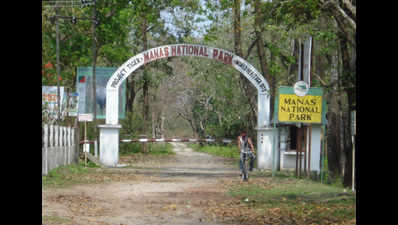- News
- City News
- guwahati News
- Tigers are making comeback in Manas landscape straddling India, Bhutan
Trending
This story is from June 23, 2016
Tigers are making comeback in Manas landscape straddling India, Bhutan
Tigers are making a comeback in the Manas landscape straddling the international boundary between Assam’s Bodoland Territorial Area District (BTAD) and Bhutan.

Tigers are making a comeback in the Manas landscape straddling the international boundary between Assam’s Bodoland Territorial Area District (BTAD) and Bhutan.
GUWAHATI: Tigers are making a comeback in the Manas landscape straddling the international boundary between Assam’s Bodoland Territorial Area District (BTAD) and Bhutan.
The second monitoring of big cats across the Transboundary Manas Conservation Area (TraMCA) covering Manas National Park (MNP) in Indian side and the Royal Manas National Park (RMNP) in Bhutan has found altogether 21 individual tigers.
The first monitoring in TraMCA in 2011-12 found 14 individual tigers in the landscape.
The monitoring carried out by the MNP, RMNP, National Tiger Conservation Authority (NTCA), WWF-India and Aaaranyak last year, covered an area of 560 sq km of the two protected areas. The report of the findings was released by the Assam principal chief conservator of forest D Mathur at the two-day TraMCA meeting that concluded here on Wednesday.
TraMCA, floated in 2008, is a joint initiative of India and Bhutan for trans-boundary biodiversity conservation across the international boundary. The landscape includes MNP in India and RMNP, Phipsoo wildlife sanctuary and Jomotshangkha wildlife sanctuary in Bhutan.
The latest report said that 11 tigers were found in RMNP and 14 in MNP. However, as four tigers were spotted on both sides of the border, the total individual tiger count stood at 21.
The study said that the presence of four tigers in both sides of the international border underscored the importance of maintaining the landscape connectivity within TraMCA for long term conservation of big cats.
“In the face of increasing illegal wildlife trade, habitat loss and human-wildlife con?ict, continuity of annual joint monitoring of tigers is paramount to help enhance management capabilities and gauge the ef?cacy of conservation actions,” the report said.
The second monitoring of big cats across the Transboundary Manas Conservation Area (TraMCA) covering Manas National Park (MNP) in Indian side and the Royal Manas National Park (RMNP) in Bhutan has found altogether 21 individual tigers.
The first monitoring in TraMCA in 2011-12 found 14 individual tigers in the landscape.
The monitoring carried out by the MNP, RMNP, National Tiger Conservation Authority (NTCA), WWF-India and Aaaranyak last year, covered an area of 560 sq km of the two protected areas. The report of the findings was released by the Assam principal chief conservator of forest D Mathur at the two-day TraMCA meeting that concluded here on Wednesday.
“The findings showed that there is an increase in tiger population, making the landscape a crucial for trans-boundary conservation,” head of WWF-India’s Assam Landscapes, Anupam Sarmah said.
TraMCA, floated in 2008, is a joint initiative of India and Bhutan for trans-boundary biodiversity conservation across the international boundary. The landscape includes MNP in India and RMNP, Phipsoo wildlife sanctuary and Jomotshangkha wildlife sanctuary in Bhutan.
The latest report said that 11 tigers were found in RMNP and 14 in MNP. However, as four tigers were spotted on both sides of the border, the total individual tiger count stood at 21.
The study said that the presence of four tigers in both sides of the international border underscored the importance of maintaining the landscape connectivity within TraMCA for long term conservation of big cats.
“In the face of increasing illegal wildlife trade, habitat loss and human-wildlife con?ict, continuity of annual joint monitoring of tigers is paramount to help enhance management capabilities and gauge the ef?cacy of conservation actions,” the report said.
End of Article
FOLLOW US ON SOCIAL MEDIA










